| Article ID | Journal | Published Year | Pages | File Type |
|---|---|---|---|---|
| 10902367 | Cancer Letters | 2015 | 32 Pages |
Abstract
Glioblastoma (GBM) is the most common and aggressive primary brain tumor. Great interest persists in useful therapeutic targets in GBM. Aberrant expression of long non-coding RNAs (lncRNAs) has been functionally associated with many cancers. Here, we elucidated the function and the possible molecular mechanisms of lncRNA XIST in human glioblastoma stem cells (GSCs). Our results proved that XIST expression was up-regulated in glioma tissues and GSCs. Functionally, knockdown of XIST exerted tumor-suppressive functions by reducing cell proliferation, migration and invasion as well as inducing apoptosis. The in vivo studies also showed that knockdown of XIST suppressed tumor growth and produced high survival in nude mice. Further, there was reciprocal repression between XIST and miR-152. Mechanistic investigations defined the direct binding ability of the predicted miR-152 binding site on the XIST. In addition, XIST and miR-152 are probably in the same RNA induced silencing complex (RISC). Finally, miR-152 mediated the tumor-suppressive effects that knockdown of XIST exerted. Taken together, these results provided a comprehensive analysis of XIST in GSCs and important clues for understanding the key roles of lncRNA-miRNA functional network in human glioma.
Related Topics
Life Sciences
Biochemistry, Genetics and Molecular Biology
Cancer Research
Authors
Yilong Yao, Jun Ma, Yixue Xue, Ping Wang, Zhen Li, Jing Liu, Liangyu Chen, Zhuo Xi, Hao Teng, Zhenhua Wang, Zhiqing Li, Yunhui Liu,
